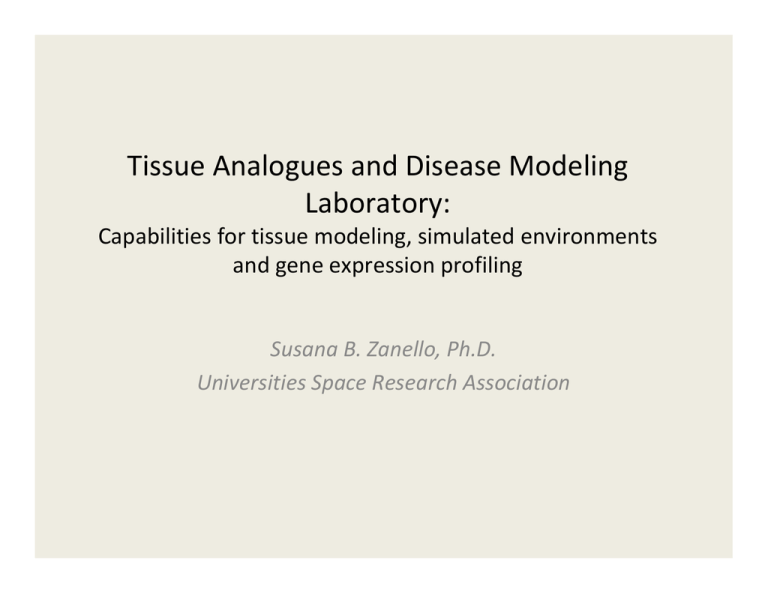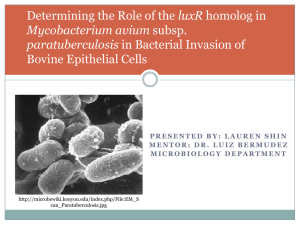Tissue Analogues and Disease Modeling Laboratory: Capabilities for tissue modeling, simulated environments and gene expression profiling
advertisement

Tissue Analogues and Disease Modeling Laboratory: Capabilities for tissue modeling, simulated environments and gene expression profiling Susana B. Zanello, Ph.D. Universities Space Research Association 3D Tissue culture technologies a) Spheroids: multicellular aggregates in liquid culture hepatocytes b) Cell aggregates in Matrigel-like subtrate Chondrocytes derived from IV discs, expressing abundant CS, KS, Col I and Col II (Gruber & Hanley, Musculoskelet Disord 2000; 1:1) c) Stratified cell culture Porcine corneal section Reconstructed step-by step human corneal model (Reichl et al, Br J Ophthalmol 2004) d) Rotating Wall Vessel (RWV) • Developed by NASA •Based on clinorotation (ESA uses the Random Positioning machine), nullifies gravity •Minimal shear force •Coaxial oxygenator rotates at same angular velocity • Vessel and liquid medium rotate as a solid body, resulting in counterbalancing forces •Rotational speed is adjusted to aggregate size • • • • • Advantageous features of the NASA bioreactor Cells establish cell‐cell contacts (and cell‐ substrate contacts) critical for cell signaling Spatial freedom to acquire organotypic 3D‐ structures, resembling native tissue Mass transfer of nutrients and oxygen is limited by the static nature of some cultures, solved by the RWV. Microgravity simulation Long term cultures Tissue culture assembly steps ASSEMBLY of 3 – DIMENSIONAL TISSUE ASSEMBLY into HIGH ASPECT ROTATING WALL VESSEL (STLV) CELL/TISSUE ALIQUOT 2 – D TISSUE CULTURE FLASKS CELL CLONAL EXPANSION TRYPSINIZE MICROCARRIER BEADS CELL COUNT 106/ ml. LOAD CELLS and BEADS RWV MICROSCOPIC AND GENETIC/PROTEOMIC ANALYSIS DETERMINE OPTIMAL CELL DENSITY for RWV CONICAL TUBE with CELLS 3 Goodwin Simulation of space environment Microgravity Other conditions Examples: Radiation Δ pO2 Thermal stress Nutritional stress Analysis: •Histology •Proteomics (tissue or secreted proteins) •Gene expression epithelium Keratocytes ECM layers stroma endothelium Example: 3D- Corneal model B A 2 1 Microcarrier bead Vimentin (+) keratocytes C D E 3 1 5 4 Chondrotin-4-sulfate Chondrotin-6-sulfate (+) cells fibronectin Goodwin, T. Prototypic Experimental Design Human corneal analog Hypoxia/hyperoxia regimen pO2 (mmHg) Pumped O2 Pumped O2 175 150 110 Reduced mix 2 8 10 Expression profiling Gene expression Proteomic analysis Days PROTEOMICS Diagram of the current core proteomic technologies as well as the four key applications they drive in advancing biology and medicine Drake, T. A. et al. J. Lipid Res. 2007;48:1-8 Copyright ©2007 American Society for Biochemistry and Molecular Biology 2D GEL ELECTROPHORESIS (+) (-) (-) high pI M.W. Individual proteins (+) low IEF strip Protein extract Second dimension separation pH 3 pH 10 Normal cultured keratocytes GRP-78 k1, k2, k3 Cofilin-1 Cofilin-1 GRP-78 kc3 kc2 kc1 Vimentin cluster keratoconus Zanello et al, CER 2006 Comparison Cut spot In-gel digestion Peptides Mass spectrometry The ProteinChip System (Ciphergen, now commercialized by BioRad) Comprised of: • ProteinChip Arrays: capture proteins from mix due to different chromatographic chemistries • ProteinChip Reader: laser desorption/ionization TOF mass spectrometer, calculates MW and mass. • ProteinChip Software: controls the reader and collects and analyzes data • Range of detection: small molecules to big proteins (1000 Da‐ 500 kDa) SELDI ProteinChip ® Array Technology Reddy & Dalmasso, J Biomed Biotechnol. 2003 Reference intervals for 70 protein analytes in plasma Anderson, N. L. (2002) Mol. Cell. Proteomics 1: 845-867 Copyright ©2002 American Society for Biochemistry and Molecular Biology LUMINEX TECHNOLOGY •Wide range of multiplexed bioassays: able to detect up to 100 analytes simultaneously •Immunoassays, receptor-ligand interactions, enzyme assays, nucleic acids •Currently we do a “multiplexed ELISA in solution” concentration (pg/ml) MMP-13 levels in human chondrocytes 2000 1500 Control 1000 Treatment 500 0 0 10 20 29 time (days) GENE EXPRESSION PROFILING High‐throughput (HT) approaches • “Next‐generation” sequencing includes multiple fast and efficient sequencing platforms with various applications • Study of the transcriptome is now possible with sensitivity down to a single molecule of mRNA • Microarrays: Human Genome U133 Plus 2.0 Genechip, Affymetrix qPCR validation(real time semi‐quantitative PCR) PCR basics Real time PCR Real time PCR fluorescent chemistries HP RT 1 B2 M β2 TG F TG Fβ 1 IG F1 IL8 IL6 bF GF bp VE GF Cytokine RT-PCR products from human chondrocyte 3D cultures 500 125 75 •* Notes:Each product shown in duplicate, from “control” and “treated” samples, respectively • In green, housekeeping genes VE-cad L19 “Sharp” melting curves are critical for adequate quantitation using SYRBR green Semi-quantitative (normalized) qPCR relative to control condition Treatment TaqMan primers/probes targeted Genes + Toll-like receptor pathways related genes screened by PCR arrays (SABioasciences) Subtotal = approx 110 genes studied + Microarray analysis Total = more than 1000 genes analyzed !!! Is this too much information? How can we use this information to build an organized gene network and cellular pathway from expression data? LITERATURE BASED DATA MINING EXPERIMENTAL •Expression profiles Bioinformatic tools Elucidation of biological pathways and control mechanisms underlying a biological response •Known pathways •Known gene networks •Prot-prot interactions •Prot-DNA interactions Comparison of network analysis platforms Cline et al, Nature Protocols 2007 Cellular assays 3D-HCH cultures and conditions DNAmicroarrays Differentiallyexpressed genes TaqMan and PCRArrays Luminex MMP levels Integrated Bioinformatics Expression profiling+pathway/network mapping GenMAPP Pathways Hypotheses Candidates for validation Acknowledgements Tissue Analogues Laboratory JSC Core Lab Facility •Dr. Thomas Goodwin •Dr. Dianne Hammond •Maureen McCarthy Bioinformatic Websites used: • www.cytoscape.org •www.genmapp.org •www.wikipathways.org







